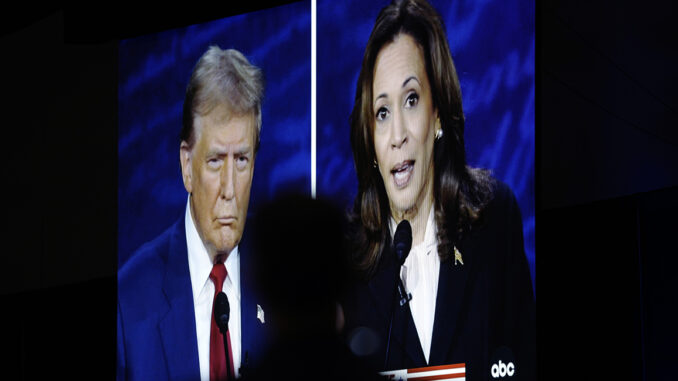
Not everything significant politically is happening just in the target states.
“Never seen anything like this in 30 years,” said California Republican consultant Mike Madrid in an X post, referencing the sharp increase in Republican registration among California’s minority voters, including the state’s numerous Latinos, growing numbers of Asians and decreasing number of blacks. This is especially evident among Latinos, as shown by mock elections in the state’s majority-Hispanic public schools, in which former President Donald Trump got 18% of voters in 2020 and 35% so far this year.
These changes are not going to make California go Republican on Nov. 5, but they’re part of a nationwide Republican trend among so-called minorities that may help Trump carry several target states with large percentages of Hispanics (Arizona and Nevada) and blacks (Georgia, North Carolina, Michigan and Pennsylvania).
Definitive confirmation of what has been scattered evidence comes from the latest, very highly rated New York Times/Siena poll, which oversampled Hispanics and blacks. The outlet’s chief political analyst, Nate Cohn, reported last weekend that Trump is trailing Vice President Kamala Harris by 78%-15% among blacks and by only 56%-37% among Hispanics. Trump, Cohn said, “might well return to the White House by faring better among black and Hispanic voters combined than any Republican presidential nominee since the enactment of the Civil Rights Act in 1964.”
This not only alarms but also puzzles many Democrats. Commenters responded in disbelief to Madrid’s post.
“I cannot think of 1 single thing that Trump has or will do for Latinos,” said Lisa Grande.
“Specifically, why?” asked DebJM. “GOP has no policy that benefits either group. In fact, they stigmatized all those groups mentioned.”
Something similar came from as exalted and successful a political analyst as former President Barack Obama. Speaking in Pittsburgh last Thursday, the former president, who won 365 and 332 electoral votes (of 538) in 2008 and 2012, respectively, upbraided black voters, especially men.
“Part of it makes me think — and I’m speaking to men directly,” he said, “that, well, you just aren’t feeling the idea of having a woman as president.”
Similar to a jazz artist improvising on a theme, Obama continued, “Women in our lives have been getting our backs this entire time. … And now, you’re thinking about sitting out or supporting somebody who has a history of denigrating you because you think that’s a sign of strength because that’s what being a man is? Putting women down? That’s not acceptable.”
It’s not generally considered good persuasion tactics to accuse voters of bigotry and insist they confess error, but Obama seemed to be appealing to a longtime theme in black politics.
Liberals might be less puzzled if they read Cohn’s analysis. He points out that nearly half of Hispanic and black voters support a southern border wall and deportation of illegal immigrants. About half of minorities, like half of whites, say big city crime is out of control. Majorities of blacks and Hispanics favor an “America first” foreign policy.
Moreover, under 30% of blacks and Hispanics rate the economy positively, and 61% of Hispanics and 25% of blacks, for whom the economy is the most important concern, favor Trump. As the Democratic Party becomes dominated by left-wing woke progressives and more liberal white college graduates, attitudes rooted in history that had prompted blacks and Hispanics to vote near-unanimously or heavily Democratic have been thrust aside.
Near-majorities of Hispanics and substantial numbers of blacks have become, in Ruy Teixeira’s, a liberal patriot writer, phrase, “normie voters.” Just as in their daily lives, I suspect, they live similarly to normie Americans. The rigid and often violently imposed regime of segregation and subordination described in anthropologist John Dollard’s 1937 “Caste and Class in a Southern Town” has been long gone, and increasingly, though not completely, black Americans go about working, shopping and enjoying leisure activities without stigma or disrespect.
Let us go back to where this column started: California. I see a historical analogy. Just as the largely midwestern migration there in 1940-65 led to Democratic victories and then, in response to the Watts riot and Berkeley rebellions, the 1966 turn to the conservatism of Ronald Reagan, the largely Mexican migration in 1982-2007 led to Democratic victories, and now, in response to the Biden inflation, illegal immigration and COVID-19 lockdowns, we’re seeing a 2024 movement toward the populism of Trump.
If the Democratic Party has always been a coalition of outgroups, when members of an outgroup start feeling like normies, they may turn to the Republicans, who have always been centered on a core group of people regarded as typical Americans. While this process goes on, we may see the two parties in very close balance.
Michael Barone is a senior political analyst for the Washington Examiner, resident fellow at the American Enterprise Institute and longtime co-author of “The Almanac of American Politics.”


